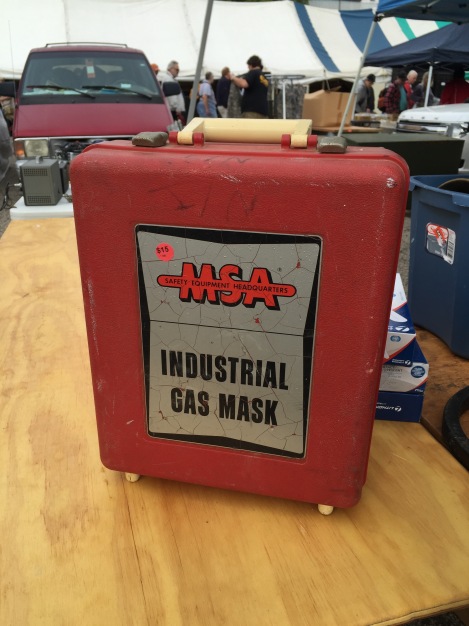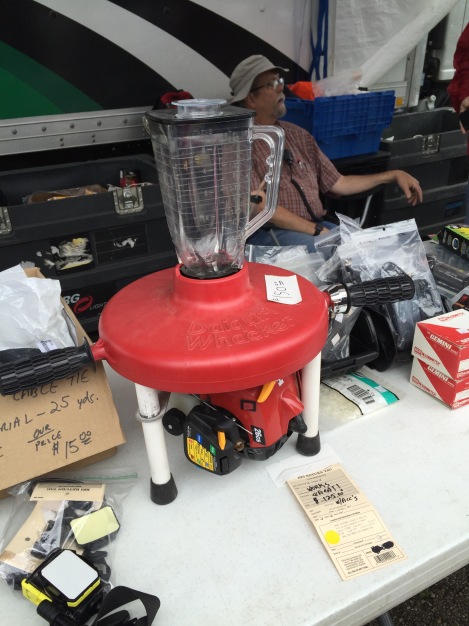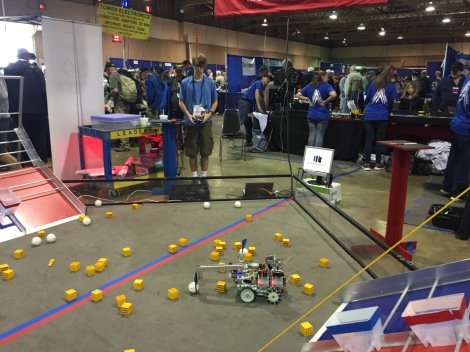Posts Tagged ‘Uncategorized’
 Dayton 2016
Dayton 2016
Another year, another Dayton in the history books. This was my third Hamvention trek, but this year was a bit different for me as I attended with my girlfriend. She somehow coaxed me into it, despite my concerns she would be bored out of her mind. However, we both had a great time.

Happy Hamventioners
I didn’t take as many pictures this year. At times I felt I could have recycled photos from the last two years and no one would notice. But there were some new sights to see….

Mannequintenna?
Yaesu was handing out truckloads of free “Yaesu 60th Anniversary” hats and other logo-adorned swag as usual. I was tempted to alter a hat to say “Yaesu FT-817 60th Anniversary” as the long-in-the-tooth rig continues to be offered with no modern update in sight. Ride that pony, Yaesu. As Jeff KE9V reported, no, the FT-891 is not an 817 replacement. It’s not an FT-897 replacement, either, so don’t ask. The FT-817 continues to be the Keith Richards of amateur radio rigs.

Required Equipment in Hara Arena Bathrooms
The Kenwood booth actually had visitors in contrast with last year when there were more tumbleweeds than attendees. Their newly announced super duper digital VHF/UHF rig undoubtedly attracted inquiries, though shame on their product line management people for not having it ready to sell at Dayton. In Kenwood’s defense, Yaesu’s new FT-891 wasn’t available for purchase, either.

When All Else Fails, Make a Daiquiri
The crazy rig-selling train known as Elecraft continues barreling down the track. As everyone is undoubtedly well aware now, they released the KX2 at the Hamvention. No, this isn’t an X-rated version of the K2, or two K1s merged together, it’s a smaller KX3 without 6 meters or 2 meter add-on capability. This rig could have been a Yaesu FT-817 killer if it had VHF and UHF capability and reasonable pricing. 2 meter capability especially would have made sense to include considering this rig has the size and essentially the form factor of an HT. No doubt Elecraft will sell a ton of these rigs, but then again if they released a new version of the K1 packaged in a 55 gallon drum, they would sell them by the dump truck load.
I question how much longer Elecraft can keep up this sales momentum which I often feel is fueled by unreasonable customer loyalty. (Full disclosure: I own three Elecraft rigs.) Last year’s big announcement was the K3S, an improved K3, which teed off new K3 owners. This year’s release was a repackaged KX3. Elecraft seems to be innovating less and recycling products more.

Domo Arigato, Mr. Roboto
I’m pleased to report there was a robot competition area and a local Makerspace representative booth. It’s good to see more Maker-oriented vendors and displays, which is really going to be the key to growing amateur radio after our older amateurs go silent key in the next decade. Hamvention folks, please, keep increasing this type of content.

Mendelson’s Flea Market Tent Family Planning Center
The flea market appeared to be the same size, with many long standing attendees selling the same junk, I mean, classic wares. I think there were less amplifiers for sale this year. That’s just a gut feeling, but I seem to recall many more amps last year. The same goes for rigs.

No Hamvention report would be complete without mentioning the condition of Hara Arena. Yes, good old Hara Arena. This is the final year for Hara. Seriously. I’m going on record and predicting it now. Really. This is it. Seriously. Last year’s announced multi-million dollar renovation plan fell through. I can’t imagine the facility can continue operating in its ever-worsening condition as it’s become a human safety nightmare that would cause any sane insurance company underwriter to run away screaming like their hair was on fire. Expect something to happen prior to the next Hamvention, either the occupancy permit being revoked, or the building turning into a pile a rubble on its own or by wrecking ball. Last year. Trust me. That being said, I left late afternoon Saturday sadly waving bye to Hara Arena thinking this may be the last year, like I was losing a dying friend. But the Hamvention is not Hara Arena, and Hara is not the Hamvention.
 Backup Your Shack PC
Backup Your Shack PC
We recently passed World Backup Day on March 31st. These days there seems to be a day for everything, important or not. Backing up your computer data is more important than a lot of people think. I don’t know how many times someone has brought me their computer asking for help when they can’t access something on it. My first question is usually “Do you have a backup?” And the response is more often than not “No! That’s why I need help”. Occasionally I am able to save their data but if their disk drive is too far gone, then it’s lost.
Consider what’s on your computer. I have years and years of digital photos, purchased music files, and a lot of important documents. That doesn’t even begin to cover my ham radio related data. The important things as far as I am concerned that I would rather not lose are my logs, LOTW TQSL certificate files, data files for programming my radios and other data files like antenna plans and such.
Ask yourself this question . . . “Can I get all that stuff back if something terrible happens to my computer and the data is no longer accessible?”
You should be able to answer “Yes, I can!”
I am not going to go into all the possible ways to backup your data. There are USB drives, thumb drives, online services or you can build a home backup server. This article isn’t going to review all those possibilities and I am sure there is some method I left out of this short list.
Consider the 3-2-1 backup rule. The 3-2-1 strategy means having at least 3 copies of your data, 2 of which are on different mediums (i.e.: devices) and at least 1 copy off site. The key to this, is that all 3 copies need to be reasonably up to date. Having the offsite copy too old doesn’t do much good if that’s the one you need to use for a restore.
For my home computers, I use a network drive and an online service. So I have my original copy, my onsite network drive copy, and the offsite online service as my third copy. You don’t have to use an online service. I just like the automatic online, offsite backup.
Another important thing to consider, is the restore itself. Your backup is only as good as your ability to restore it. Occasionally restoring a specific file is a nice test. Backing things up in some super-duper format isn’t any good if it’s too difficult to restore. Also think about how you would restore the operating system and not just your data. You likely don’t need to backup the operating system as most people have restore disks that shipped with their computer or some other install method for the OS.
So, please think about what and how you backup your data. Can you restore it? Do you have an offsite copy? What if I lose my main hard rive and it’s contents?
While those are not nice thoughts, it’s better to be prepared than not . . . . And it seems like a lot of the Ham Radio hobby/service is about being prepared in one form or another.
 National Amateur Radio Equipment Manufacturers Recommendation
National Amateur Radio Equipment Manufacturers Recommendation
Last week the National Amateur Radio Manufacturers’ Association met in Orlando, Florida. The annual invitation-only event is an industry get-together of major companies that make amateur radio equipment where trends in technology, standards, and the overall direction of amateur radio is discussed.
This year the industry group released an official recommendation regarding amateur radio equipment obsolescence, urging all amateur radio operators to replace all their rigs on an annual basis. Several manufacturers spoke about the recommendation and the reasoning behind it.
Elecraft spokesman Ed Jabloski advised hams to follow the recommendation due to performance concerns. “We released the K3S in May 2015 to address the now mediocre performance of the K3. The K3S, which is nearly a year old, is approaching obsolescence. We intend on releasing the K3S+ soon in which we improve several key performance metrics by at least a two tenths of a dB. Amateurs not using this new and modern technology risk their QSOs while using substandard and aging rigs, like the K3. But also, regardless of new model releases, having new rigs each year will insure that you have the latest and best performance from new components and software.”
Kenwood representatives had a different take on the annual rig replacement recommendation. “We see it as more of something that gives hams peace of mind.” stated John Finley, of the Kenwood sales and marketing group. “Take for example the Kenwood TS-590S. That rig had a RF output power spike bug. While we have a factory modification to correct the power spike issue, we released the updated TS-590SG which doesn’t have the nasty power spike. Do you really want to be on the air with a rig with a output power spike problem? I mean, it’s just very, very risky….very scary. If you have a TS-590S you really should destroy it and buy a brand new TS-590SG. And really, do this each year with all your transceivers. It’s irresponsible to sell old rigs on Ebay.”
Baofeng attended the manufacturer event for the first time this year. “We already support the annual rig replacement methodology.” noted Alex Taylor, a US Baofeng representative. “Our rigs tend to last about a year anyway, and getting a new, fresh rig annually is common for our customers. We’re proud that we have supported the annual rig replacement initiative from day one.”
The recommendation will undoubtedly have radio amateurs scrambling to refresh their hamshacks with new rigs, and may have a positive impact on Dayton Hamvention 2016 vendor sales and attendee numbers. All manufacturer representatives at the National Amateur Radio Manufacturers’ Association event stated they were ramping up production to be able to support the recommendation and meet the demands of hams.
 AO-73 Funcube and AO-85 Fox 1 Satellites Collide
AO-73 Funcube and AO-85 Fox 1 Satellites Collide
In a shocking turn of events in the amateur satellite community, AMSAT-NA is claiming AMSAT-UK steered their AO-73 Funcube satellite into the AMSAT-NA AO-85 Fox 1 bird. NORAD satellite tracking confirmed at 0200Z a combined debris path consistent with the orbits of both satellites. Both satellites are silent and assumed totally destroyed. AMSAT-NA officials in a press conference called the move by AMSAT-UK an “act of war” and promised swift retaliation but wouldn’t give details on the next move. AMSAT-UK officials taunted AMSAT-NA with several incendiary tweets.

In other satellite news, North Korea announced their plans to launch the first of many amateur radio satellites. The satellites were described as being “worthy of Supreme Leader” and will feature outrageously over-modulated audio similar to North Korean state run television so that North Koreans can properly understand each other when communicating through the satellites.
 RPiGate again
RPiGate again
For a few weeks I have been attempting to use an RTL-SDR and a raspberry Pi 2 as an APRS iGate. Dutifully following a number of tutorials I failed to ‘Kalibrate’ the dongle several times and so put it to one side. Today however I have managed to get the thing running. Not with the original tutorial but with a different application called ‘Direwolf’.
There are quite a few clever sods kicking about and the guy who pulled this together is no exception. John Langer,WB2OSZ has not only produced a cracking application but also one of the most straightforward and detailed installation documents as well. What I particularly liked was the way that there was a step followed by an explanation of what the step was meant to achieve. I’m no great linux fan, partly because I don’t understand what the hell is going on and more importantly for me, why its not doing what I thought it should do and why. This small success may point me more in that direction though.
More to the point see. I told you it was working!
 New Heathkit Antenna Offering
New Heathkit Antenna Offering
The reincarnated Heathkit company has a new product offering, the Pipetenna, a 2 meter and 440 antenna. Heathkit claims the antenna is stealth and high performance, featuring a colored, rounded end PVC tubing sort of look. It’s really not that difficult to build a stealth at VHF and UHF frequencies due to the short wavelengths involved. The specifications of the antenna lists the gain on 2 meters as 6 dBi, which doesn’t scream high performance. Puzzlingly, no gain figure is listed for 440.
Heathkit proclaims the antenna has multiple patents filed for many inventions in its design and is waterproof, yes waterproof. I thought all antennas should be waterproof in the first place, or at least not be affected significantly by rain. To Heathkit’s defense they go on about how it can be used on a ship or by the ocean where there is corrosive saltwater. But this isn’t a really novel antenna feature. What is perhaps a truly novel feature is the choice of colors, currently Light Sky Blue and Olive Green, with other colors such as Terracotta and Camouflage Green listed but grayed-out on the order form.
The antenna sports an N connector, with Heathkit citing that it eliminates an impedance bump, presumably when compared to the common UHF connector. While this is technically true and the N connector is overall a better connector, the impedance bump of a UHF connector at 2 meters and 440 is negligible. Furthermore, most of the target audience of this product probably have never dealt with an N connector before. Perhaps more amateurs should become familiar with the N connector, but it’s overkill for this application.
The Pipetenna has me and presumably others scratching their heads, much like their premier offering, a pricey speaker-lacking TRF AM radio kit. Overall the Pipetenna is heavy on marketing but light on compelling technical reasons to buy, in my opinion. Amateurs wanting to learn about VHF/UHF antennas who aren’t so interested in a vintage Heathkit experience could better spend their money constructing a ground plane or J pole antenna.
While the new owners of Heathkit undoubtedly need to take baby steps in building what is essentially a new company from the ground up, these initial product offerings are disappointing and somewhat bizarre. Some people probably have unrealistic expectations of Heathkit bringing back original tube radio kits from decades ago. It’s not out of the realm of possibilities for Heathkit to release an updated HW-9 QRP rig or some new minimalist handful-of-2N2222s QRP rig. Even if an “HW-10” design wasn’t significantly improved or a minimalist rig offering wasn’t a great performer, the QRP community, known for its rabid appetite for new rigs, would buy a new HW offering in droves. Such a rig would be more true to Heathkit’s roots and legacy than the eclectic AM radio product. The level of marketing is troubling as well. The products need to speak for themselves and Heathkit needs to build a community of users that extoll the virtues of their products, something Elecraft has masterfully done and assumed the throne once occupied by Heathkit. I don’t want to be a naysayer and I truly would love to see Heathkit succeed. I think we all do.
Heathkit Pipetenna is a registered trademark of Heathkit.
This article originally appeared on Radio Artisan.
 Learning CW – The Beginning
Learning CW – The Beginning
I have decided to learn CW. Why? Because I want to, not because I have to. Yes I am one of those no-code hams!
Most of this blog post is aimed at newer hams. If someone is thinking about trying to learn CW, I hope this post might help motivate them to go for it and give it a try.
Since I became a more active ham a couple years ago, from a non-active ham, I have thought it would be nice to have a very small portable battery powered radio, and easy & quick to deploy antenna and make some QSO’s when and where I can.
The next question, once I decided to learn CW, was how to learn CW? I know in the past, people used to use cassette tapes, learning at 5 wpm (words per minute). I looked online and found that the “tapes” can still be purchased, but now they are on CD instead of tapes. From the reviews that I have read, the content has not been updated but simply copied on to CD format. So it’s the same lessons that existed in the 60’s, 70’s, 80, etc, just in a little newer delivery format. My goal isn’t 5 wpm. It’s higher. More like the 20 wpm range someday. That then leads to some “newer” methods of learning. The “Koch” method is very popular. It starts with two characters, sent at 20 wpm but with more space between the characters, making the effective overall speed slower but still with faster character speed. The key is learning characters at a faster speed, introducing another letter when you learn the first two. You keep adding letters until you eventually have them all learned. There are many web sites and programs that use this and other methods. There are also a lot of phone apps that people use to learn. A friend of mine learned CW using these apps, and I sat with him on Field Day in 2013 as he worked without a microphone, only CW. He didn’t even bring his microphone to Field Day! He now works CW almost exclusively.

After further research I came across The CW Operators Club web page, http://www.cwops.org. I found that they have a CW Academy with 3 different levels. Level I is for beginners with no CW experience and Levels II & III are more advanced working on increasing speed and other things. I decided to enroll in their Level I beginner class. I signed up on their web site and weeks later, I was confined for the Level I class that started in January ’16, a few weeks ago. I am now 5 weeks through an 8 week class. The class meets twice a week, using Skype. There are five students in my class, which is lead by an experienced instructor. Homework consists of using a web based CW training program, for receiving practice. Assuming you have a key/paddle or something to send with, there are sending exercises as well. The curriculum introduces the letters, much like the Koch method, at a 20 wpm pace, but in a different order than the standard Koch trainers. The first session consisted of four letters, and words using those four letters. If you would like more information their web site is: http://www.cwops.org
Is it working? So far it is working. Five weeks into the class, I now know the whole alphabet, the numbers 0-9 and a few punctuation characters. I say “know” them, but I am not very good at receiving yet. I miss a lot of characters when I try to listen so a real QSO on the air. Like learning anything like another language, it’s going to take some practice to get better at listening in real time. I have recorded a couple QSO’s from a websdr.org station and when I repeat it multiple times, I can figure it all out. Considering 5 weeks ago I didn’t know a single letter, I am making progress.
I’ll continue attending class, and practicing. I’ll post again later when I make some more progress and someday pretty soon, I’ll get in the air and attempt a real QSO!
Until then – – . . . . . . – –
PS “- – . . . . . . – -” is morse code for “73” in case you wondered!













